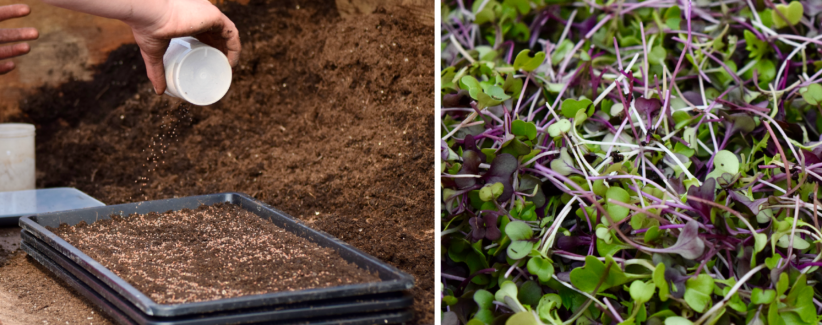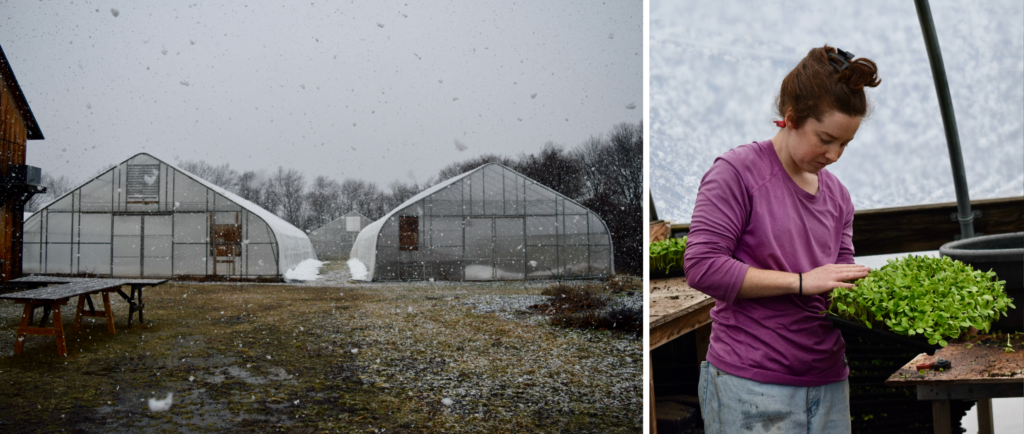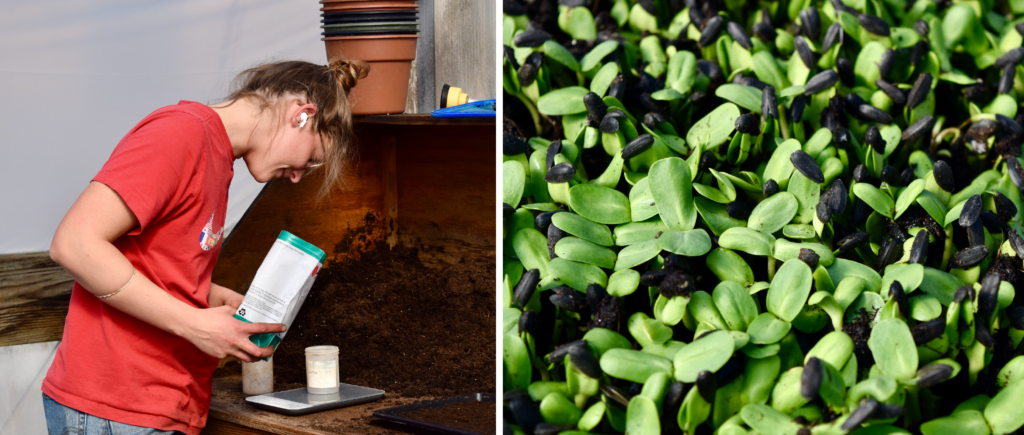Adding Winter Microgreens to the Mix

This past February, even as fresh snow blanketed the farm, it was warm inside Gaining Ground’s greenhouse. It might have been the middle of winter, but the farmers were filling trays with potting mix and weighing out seeds before dusting them onto the soil.
Led by Co-Assistant Farm Manager Kari Bender, Gaining Ground undertook an experiment to grow winter microgreens this season.
Microgreens are nutrient-dense immature greens that are harvested within one to three weeks of germination, when the tiny plants have developed their seed leaves (or cotyledons) and—depending on the species—a couple of true leaves. The young plants are still gearing up for growth, so they contain a particularly high density of nutrients and sugars in their tiny stems and leaves.
The barriers that people face when accessing the foods they need don’t go away during the cold months, which is why Gaining Ground has been working to increase and diversify the crops we distribute throughout the entire year. “We know food insecurity can become more prevalent in the winter because people need to pay their heating bills,” said Kari. “And, on top of this, there is an overall lack of fresh, locally-grown food during the winter. Microgreens have a quick turnaround and they don’t need a lot of light or time, so they are something that we can easily grow in the winter if we turn the greenhouse on.”

Given their excellent nutritional value and the variety of types that can be grown, adding microgreens to our annual crop plan allowed us to harvest and donate more fresh, local, health-promoting produce at a time when it can be especially hard to find.
“Our clients welcomed the microgreens as a sign of spring—a sign of hope,” Jill Tsakiris, programs manager at Open Table in Maynard and Concord, told us. “The greens were so visibly different from the root vegetables, winter squash, and cabbage-heavy produce we have been providing lately. The past few weeks have been tough weather-wise, but also with the ending of pandemic emergency benefits for many of our clients, so the microgreens provided a much-needed psychological lift.”
In the course of this year’s experiment, we grew and gave away 102 pounds of microgreens. Not only was it thrilling to donate these tasty new greens this winter, it was also exciting to learn about how best to grow them on the farm for our clients.
As with any new crop—especially one so uniquely fast-paced and sensitive to handling—it took time and research to sort out best practices for growing the 12 types of microgreens we distributed (which included sunflower, pea tendril, bok choy, tatsoi, mustard greens, amaranth, cilantro, radish, and broccoli). The farmers managed to prepare for and avoid some of the more commonplace issues that come with growing these plants, such as spoilage that frequently occurs when seeds are planted too densely and the lack of air flow promotes fungal growth, or losses to rodents that can easily happen when food is otherwise scarce and the greenhouse stands out like a snack-filled beacon in the cold winter months.
Perhaps the most notable difference between growing normal field crops and growing microgreens is the large quantity of potting mix and seeds they require. These can be relatively costly inputs for a farm—and they’re among the reasons microgreens can be some of the most expensive fresh vegetables by weight at the grocery store.

Because these young plants don’t extract a lot of nutrients from their growing medium, the farmers plan to repurpose the potting mix that they used for the microgreens. Later this season, they will use it to seed other fast-growing crops that will only be in the greenhouse briefly and won’t need much nutrition before being transplanted out into the fields.
“In terms of resources, it’s obviously one seed per microgreen,” said Kari. “And the proportion of food, by weight, that we get at the end is less than for our other crops.” Many of the varieties we grew this year were brassicas, the seeds for which tend to be less expensive. Others, like peas and sunflowers, have high yields but also grow from much larger seeds. Because seeds are generally priced by weight, the costs here can quickly add up for food producers.
“But, the most important question is whether there is the need and desire for microgreens,” said Kari. “There’s just something to be said for the excitement and joy of having freshly-grown, local produce in February when it’s not nice outside and you don’t otherwise see anything like this food available.”
“It makes me think about the larger issues around food insecurity and the structures that are in place to feed people that are really focused around getting people enough calories without as much focus on the nutritional value of food, the dignity of each person, or the pleasure of eating good food.”